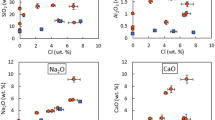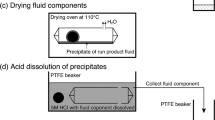Abstract
Recently measured partition coefficients for Rb, Th, U, Nb, La (Ce), Pb, Sr, Sm, Zr, and Y between lherzolite assemblage minerals and H2O-rich fluid (Ayers et al. 1997; Brenan et al. 1995a,b) are used in a two-component local equilibrium model to assess the effects of interaction between slab-derived aqueous fluids and wedge lherzolite on the trace element and isotopic composition of island arc basalts (IAB). The model includes four steps representing chemical processes, with each process represented by one equation with one adjustable parameter, in which aqueous fluid: (1) separates from eclogite in the subducted slab (Rayleigh distillation, mass fraction of fluid released F fluid); (2) ascends through the mantle wedge in isolated packets, exchanging elements and isotopes with depleted lherzolite (zone refining, the rock/fluid mass ratio n); (3) mixes with depleted lherzolite (physical mixing, the mass fraction of fluid in the mixture X fluid); (4) induces melting to form primitive IAB (batch melting, mass fraction of melt F melt). The amount of mantle lherzolite processed by the fluid in step (2) determines its isotopic and trace element signature and the relative contributions of slab and wedge to primitive IAB. Assuming an average depleted lherzolite composition and mineralogy (70% olivine, 26% orthopyroxene, 3% clinopyroxene and 1% ilmenite) and using nonlinear regression to adjust parameter values to obtain an optimal fit to the average composition of IAB (McCulloch and Gamble 1991) yields values of F fluid= 0.20, n= 26, X fluid= 0.17, and F melt= 0.15, with r 2= 0.995 and the average relative error in trace element concentration = 6%. The average composition of IAB can also effectively be modeled with no contribution from the slab other than H2O (i.e., skip model step 1): n= 27, X fluid= 0.21, F melt= 0.17, with r 2= 0.992. By the time the fluid reaches the IAB source, exchange with depleted wedge lherzolite reduces the 87Sr/86Sr ratio isotopic composition to near-mantle values and the slab contribution to <50% for all but the most incompatible elements (e.g., Pb). The IAB may retain the slab signature for elements such as B and Be that are highly incompatible and that have very low concentrations in the depleted mantle wedge. The relatively high equilibrium D mineral / fluid values measured by Ayers et al. (1997), Brenan et al. (1995a) and Stalder et al. (1998) suggest that large amounts of fluid (>5 wt%) must be added to lherzolite in the IAB source. Decreasing X fluid below 0.05 causes model results to have unacceptably high levels of error and petrologically unreasonable values of F melt. That H2O contents of IAB are generally <6 wt% suggests that not all of the H2O that metasomatizes the IAB source remains in the source to dissolve in the subsequently formed melt. Modeling of the compositions of specific primitive IAB from oceanic settings with low sediment input and depleted mantle wedges (Tonga, Marianas) shows a generally lower level of fluid-wedge interaction (low n), and therefore a larger slab component in primitive IAB.
Similar content being viewed by others
Author information
Authors and Affiliations
Additional information
Received: 6 October 1997 / Accepted: 8 May 1998
Rights and permissions
About this article
Cite this article
Ayers, J. Trace element modeling of aqueous fluid – peridotite interaction in the mantle wedge of subduction zones. Contrib Mineral Petrol 132, 390–404 (1998). https://doi.org/10.1007/s004100050431
Issue Date:
DOI: https://doi.org/10.1007/s004100050431




